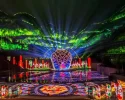2018-10-19
The biggest difference between LED lighting and traditional lighting is that LED lighting is a complete electronic product, while traditional lighting is only an electrical product. Therefore, LED lamps and lanterns can be easily associated with various types of sensors, thus realizing various automatic control functions such as light control, infrared control and so on. For example, the automatic switch of LED street lamp can be easily realized with a photosensitive sensor; for the night walkway and courtyard lighting in communities, infrared sensors can be used to collect information about human activities and automatically turn on and off lighting fixtures.

Automatic Control of LED Lighting Switch
Sensors as signal acquisition and electromechanical conversion devices, their electromechanical technology has been quite mature. In recent years, the rise of micro-electromechanical system (MEMS) technology has made great strides towards miniaturization, intelligent, multi-functional, low-cost sensor technology. All kinds of sensors, such as photosensitive sensor, infrared sensor and so on, can form an intelligent control system with LED illumination lamps. The sensor converts all kinds of physical signals collected into electrical signals. The collected signals can be input by integrated AD (analog-to-digital) converter, MCU (microcontroller), DA (digital-to-analog) converter. Intelligent processing is adopted to control the opening and closing of LED lighting fixtures. Human beings can set various control requirements on MCU to control the switching time, brightness, color rendering and multi-color variation of LED lights, so as to achieve the goal of power saving and energy saving. The system block diagram of sensor and LED lamp. The current integrated circuit manufacturing technology can integrate AD, DA and MCU into a 5 mm *5 mm package or smaller, which is not only convenient to install in the lamp, but also does not occupy an area.
Combination of Photosensitive Sensors and LED Lamps
Wind-photovoltaic LED street lamp is a highly intelligent and unattended road lighting lamp. It uses wind and sunlight to generate electricity, and uses batteries to store energy. Therefore, the automatic management of energy is very important. The photosensitive sensor is an ideal electronic sensor which can control the automatic switch of the circuit because of the illumination change in daylight and dark (sunrise and sunset).
The photosensitive sensor can automatically control the opening and closing of LED lighting in shopping malls according to weather, time and region. Convenience stores with an area of 200 m2 can reduce power consumption by 53% in bright days by reducing their output power. Life expectancy is also about 5 to 100,000 hours. Usually, the life of LED lighting fixtures is about 40,000 hours; RGB (red, green and blue) can also be used to illuminate colorful and changeable colors, so that the shopping mall lights are more colorful and the atmosphere is more active; compared with the original blue LED with yellow fluorescent body, the purple LED with red, green and blue fluorescent body can perform better.
Combination of Infrared Sensor and LED Lamps
Infrared sensors work by detecting infrared rays emitted by human bodies. The main principle is that the infrared radiation emitted by human body is enhanced by Fresnel filter lens and gathered on the pyroelectric element PIR (passive infrared) detector. When human is active, the emission position of infrared radiation will change, the element will lose charge balance, and the pyroelectric effect will release charge outward. The change of infrared radiation energy through Fresnel filter lens is transformed into electrical signal by external sensor, namely thermoelectric conversion. When no human body moves in the detection area of passive infrared detector, the infrared sensor only senses the background temperature. When the human body enters the detection area, through the Fresnel lens, the pyroelectric infrared sensor senses the difference between the human body temperature and the background temperature. The signal is collected and the detection data already exist in the system. Comparisons are made to determine whether infrared sources, such as people, actually enter the detection area.
Passive infrared sensor has three key components: Fresnel filter lens, pyroelectric infrared sensor and matched low noise amplifier. Fresnel lens has two functions: one is focusing, i.e. refracting pyroinfrared signals on PIR; the other is dividing the detection area into several bright and dark areas, so that moving objects/people entering the detection area can produce pyroinfrared signals on PIR in the form of temperature changes. Generally, a low noise amplifier is matched. When the ambient temperature of the detector rises, especially when it is close to the normal body temperature (37 C), the sensitivity of the sensor decreases, and the gain is compensated to increase its sensitivity. The output signal can be used to drive the electronic switch to realize the switch control of the LED lighting circuit.
Ultrasound sensors, similar to infrared sensors, have been more widely used in the automatic detection of moving objects in recent years. Ultrasound sensor mainly uses Doppler principle to transmit high-frequency ultrasound beyond human perception through crystal oscillation. Typically, 25-40 kHz wave is selected, and then the frequency of reflected wave is detected by control module. If there is movement of object in the area, the frequency of reflected wave will fluctuate slightly, that is, Doppler effect. This judges the object movement in the illumination area, so as to achieve the purpose of controlling the switch.
The longitudinal oscillation characteristics of ultrasound can be propagated in gas, liquid and solid with different propagation velocities. It also has refraction and reflection phenomena, which have lower frequency and faster attenuation in air, but smaller attenuation and farther transmission in solid and liquid. Ultrasound sensors make use of these characteristics of ultrasound. Ultrasound sensors have many advantages, such as wide sensitivity, no blind area and no interference from obstacles. This technology has been used in commercial and security fields for more than 25 years, and has been proved to be the most effective method to detect small object motion. Therefore, the system is composed of sensitive control switch and LED lamp.
Because of the high sensitivity of the ultrasonic sensor, air vibration, ventilation, heating and refrigeration system and the movement of adjacent space will cause the false trigger of the ultrasonic sensor, so the ultrasonic sensor needs to be calibrated in time.
Temperature Sensor for Overtemperature Protection of LED Lamps
Temperature sensor NTC (negative temperature coefficient) has been widely used for over-temperature protection of LED lamps. If high-power LED light source is used in LED lamps, multi-wing aluminum radiator must be used. Because the space of LED lamps used for indoor lighting is very small, the problem of heat dissipation is still one of the biggest technical bottlenecks. If the heat dissipation of LED lamps is not good, it will lead to the early light decay of LED light source due to overheating. When the LED lamps are turned on, the heat will be enriched to the lamp head because of the automatic rise of hot air, which will affect the life of the power supply. Therefore, when designing LED lamps and lanterns, an NTC can be attached to the aluminium radiator near the LED light source in order to collect the temperature of the lamps and lanterns in real time. When the temperature of the aluminium radiator of the lamp cup rises, this circuit can be used to automatically reduce the output current of the constant current source, so as to cool the lamps and lanterns; when the temperature of the aluminium radiator of the lamp cup rises to a limited set value, the LED can be automatically Power supply, realize the lamp over-temperature protection, when the temperature decreases, automatically turn on the lamp.
Conclusion:
Because the LED lamp is a complete electronic product, with the diversification of the structure of the LED lamp and the expansion of its application, and with more creativity and innovation in the design of the LED lamp, more sensors will be applied in the system of the LED lighting and lighting engineering. A new era of intelligent LED lighting is coming, and the lighting life of human beings will be more and more bright and comfortable.








